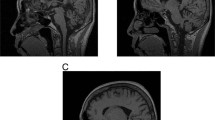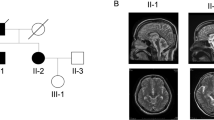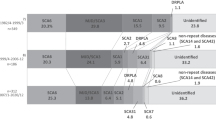Abstract
Spinocerebellar ataxia type I (SCAI) is an autosomal dominant neurodegenerative disease caused by the expansion of a CAG trinucleotide repeat on chromosome 6p. Normal alleles range from 19–36 repeats while SCA1 alleles contain 43–81 repeats. We now show that in 63% of paternal transmissions, an increase in repeat number is observed, whereas 69% of maternal transmissions showed no change or a decrease in repeat number. Sequence analysis of the repeat from 126 chromosomes reveals an interrupted repeat configuration in 98% of the unexpanded alleles but a contiguous repeat (CAG)n configuration in 30 expanded alleles from seven SCA1 families. This indicates that the repeat instability in SCA1 is more complex than a simple variation in repeat number and that the loss of an interruption predisposes the SCA1 (CAG)n to expansion.
This is a preview of subscription content, access via your institution
Access options
Subscribe to this journal
Receive 12 print issues and online access
$209.00 per year
only $17.42 per issue
Buy this article
- Purchase on SpringerLink
- Instant access to full article PDF
Prices may be subject to local taxes which are calculated during checkout
Similar content being viewed by others
References
Schut, J.W. Hereditary ataxia: clincal study through six generations. Arch. Neur. Psychiat. 63, 535–567 (1954).
Currier, R.D., Glover, G., Jackson, J.F. & Tipton, A.C. Spinocerebellar ataxia: study of a large kindred. Neurology 22, 1040–1043 (1972).
Nino, H.E. et al. A family with herediatary ataxia: HLA typing. Neurology 30, 12–20 (1980).
Zoghbi, H.Y. et al. Spinocerebellar ataxia: variable age of onset and linkage to human leukocyte antigen in a large kindred. Ann. Neurol. 23, 580–584 (1988).
Konigsmark, B.W. & Weiner, L.P. The olivopontocerebellar atrophies: a review. Medicine 49, 227–241 (1970).
Haines, J.L. et al. Spinocerebellar ataxia in a large kindred: age at onset, reproduction, and genetic linkage studies. Neurology 34, 1542–1548 (1984).
Yakura, H., Wakisaka, A., Fujimoto, S. & Itakur, K. Hereditary ataxia and HLA genotypes. New Engl. J. Med. 291, 154–155 (1974).
Morton, N.E., Lalouel, J.-M., Jackson, J.F., Currier, R.D. & Yee, S. Linkage studies in spinocerebellar ataxia (SCA). Am. J. med. Genet. 6, 251–257 (1980).
Pederson, L., Platz, P., Ryder, L.P., Lamm, L.U. & Dissing, J. A linkage study of hereditary ataxias and related disorders: evidence of heterogeneity of dominant cerebellar ataxia. Hum. Genet. 54, 371–383 (1980).
Whittington, J.E., Keats, B.B. & Jackson, J.F. Linkage studies of glyoxalase (GLO), pepsinogen (PG), spinocerebellar ataxia (SCA1), and HLA. Cytogenet. Cell Genet. 28, 145–150 (1980).
Ranum, L.P.W. et al. Localization of the autosomal dominant, HLA-linked spinocerebellar ataxia (SCA1) locus in two kindreds within an 8cM subregion of chromosome 6p. Am. J. hum. Genet. 49, 31–41 (1991).
Zoghbi, H.Y. et al. Assignment of autosomal dominant spinocerebellar ataxia (SCA1) centromeric to the HLA region on the short arm of chromosome 6, using multilocus linkage analysis. Am. J. hum. Genet. 49, 23–30 (1991).
Kwiatkowski, T.J. Jr. et al. The gene for autosomal dominant spinocerebellar ataxia (SCA1) maps centromeric to D6S89 and shows no recombination, in nine large kindreds, with a dinucleotide repeat at the AM10 locus. Am. J. hum. Genet. 53, 391–400 (1993).
Banfi, S. et al. Mapping and cloning of the critical region for the spinocerebellar ataxia type 1 gene in a yeast artificial chromosome contig spanning 1.2 Mb. (in the press).
Orr, H.T. et al. Expansion of an unstable trinucleotide CAG repeat in spinocerebellar ataxia type 1. Nature Genet. 4, 221–226 (1993).
The Huntington's Disease Collaborative Research Group. A novel gene containing a trinucleotide repeat that is expanded and unstable on Huntington's Disease chromosomes. Cell 72, 971–983 (1993).
LaSpada, A.R. et al. Androgen receptor gene mutations in X-linked spinal and bulbar muscular dystrophy. Nature 352, 77–79 (1991).
Brook, J.D. et al. Molecular basis of myotonic dystrophy. Cell 68, 799–808 (1992).
Fu, Y.-H. et al. Variation of the CGG repeat at the fragile X site results in genetic instability: resolution of the Sherman paradox. Cell 67, 1047–1058 (1991).
La Spada, A.R. et al. Meiotic stability and genotype-phenotype correlation of the trinucleotide repeat in X-linked and bulbar muscular dystrophy. Nature Genet. 2, 301–304 (1992).
Sleddens, H.F.B.M., Oostra, B.A., Brinkmann, A.O. & Trapman, Trinucleotide repeat polymorphism in the androgen receptor gene (AR). Nucl. Acids Res. 20, 1427 (1992).
Gostout, B., Liu, Q. & Sommer, S.S. “Cryptic” repeating triplets of purines and pyrimidines (cRRY(i)) are frequent and polymorphic: analysis of coding cRRY(i) in the proopiomelanocortin (POMC) and TATA-binding protein (TBP) genes. Am. J. hum. Genet. 52, 1182–1190 (1993).
Kremer, E.J. et al. Mapping of DNA instability at the Fragile X to a trinucleotide repeat sequence p(CCG)n. Science 252, 1711–1714 (1991).
Oberle, I. et al. Instability of a 550-base pair DNA segment and abnormal methylation in fragile X syndrome. Science 252, 1097–1102 (1991).
Verkerk, A.J.M.H. et al. Identification of a gene (FMR-1) containing a CGG repeat coincident with a breakpoint cluster region exhibiting length variation in Fragile X syndrome. Cell 65, 905–914 (1991).
Richards, R.I. & Sutherland, G.R. Dynamic mutations: a new class of mutations causing human disease. Cell 70, 709–712 (1992).
Author information
Authors and Affiliations
Rights and permissions
About this article
Cite this article
Chung, My., Ranum, L., Duvick, L. et al. Evidence for a mechanism predisposing to intergenerational CAG repeat instability in spinocerebellar ataxia type I. Nat Genet 5, 254–258 (1993). https://doi.org/10.1038/ng1193-254
Received:
Accepted:
Issue Date:
DOI: https://doi.org/10.1038/ng1193-254



